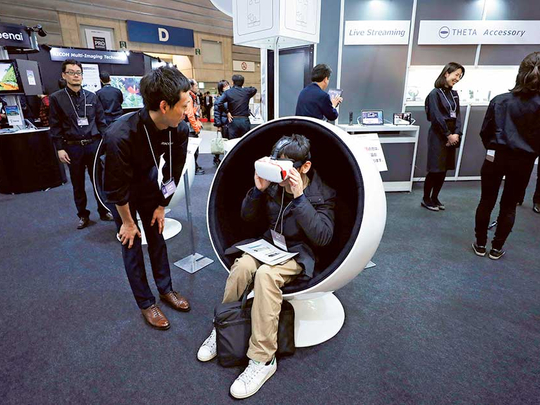
From raising money for St. Jude Children’s Research Hospital to rolling out a new airline business class service, travel companies and tourism boards are increasingly turning to virtual reality to expand their reach and entice prospective clients.
In November, for instance, the Tourism Authority of Thailand released four 360-degree videos, including one on an elephant sanctuary near Chiang Mai and another on the Khao Luang Cave in western Thailand.
“With social media and distribution channels so fragmented, we have to appeal to the senses of consumers,” said Steven Johnson Stevenson, the authority’s marketing manager for the Eastern US. “We want them to be able to touch, feel, see and hopefully one day smell Thailand.”
Virtual reality, he added, “allows consumers to interact with us in a way they never have before.”
Cathy Tull, senior vice-president of marketing for the Las Vegas Convention and Visitors Authority, said virtual reality let consumers “test drive” a destination. The most popular of the 30 360-degree videos that the Las Vegas authority has released since March is an actual drive down Las Vegas Boulevard.
“They get to experience a destination,” Tull said. “It allows them to make a decision to come.”
In January 2016, Tourism Australia introduced a series of 360-degree films depicting aquatic and coastal travel experiences there, including snorkelling in the great barrier reef and watching the sun set over Sydney Harbor.
“We have a very competitive landscape in destination marketing, with national tourist offices spending a lot of money,” said Lisa Ronson, the group’s chief marketing officer. “We need to be able to tell the story of Australia in new and engaging ways.”
Then there is the desire of some companies to appear cutting-edge. Maria Walter, managing director of product development and brand strategy for United Airlines, said one reason it had opted to use virtual reality to begin promoting its new Polaris business class service last summer was that the technology could help the carrier re-establish itself as an innovator.
More than 10,000 people — members of the general public and travel trade, as well as United employees — watched a 360-degree virtual reality demonstration of Polaris at roadshows in the carrier’s domestic hub cities last year. More will do so at events this year in Europe, Asia and Australia.
Many people who watched the demonstration last year were using virtual reality for the first time, Walter said. “It definitely got their attention in a way a brochure would not,” she said.
Henry Harteveldt, travel analyst for Atmosphere Research, suggested that premium travel brands, as well as destinations trying to reposition themselves or reach a new group of consumers, were turning to virtual reality because it provided “authentic, breakthrough creative content”.
“You can’t just have an ad,” he said. “You have to have an experience.”
One of the earliest adopters of virtual reality was Marriott Hotels, which in 2014 introduced “teleporter” booths that it took to hotels around the US, letting guests experience a black-sand beach in Maui and the view from the top of Tower 42 in London while wearing an Oculus Rift headset.
Other hotel companies — including St Giles Hotels, a London-based company that has nine hotels worldwide, and Best Western — have followed suit.
The St Giles videos, which feature activities travellers can do at destinations where it has hotels, were made by guests who won a contest and by social media influencers it selected.
Carnival Cruise Line chose Zach King, a star on YouTube and Instagram, to appear in a 360-degree video it released in the fall to promote its latest ship, the Carnival Vista. And this spring the Marriott Rewards and Starwood Preferred Guest loyalty programmes together plan to release a series of 360-degree films on destinations worldwide.
Best Western’s strategy is more straightforward: As of last summer, it had placed 360-degree films, made with Google Street View technology, of each of its 2,000 North American hotels on YouTube. It will eventually do the same for many of its hotels overseas.
Virtual reality, said Tammy Lucas, vice-president of marketing for Best Western, “fits so perfectly into the hotel space. People really want to know what they’re going to get. It offers them an opportunity to set their expectations.”
Expedia’s take on the technology is somewhat unusual. Although it has used it in films promoting travel deals to Australia, in March it started a fund-raising campaign involving virtual reality for the St. Jude children’s hospital.
Expedia “fundamentally believes that when people travel, it affects them and the world around them,” said Vic Walia, senior director of brand marketing for the company. “It has the power to transform you and shapes your views of the world. We recognise that while most of us can travel, there’s a group of kids at St. Jude who can’t.”
At Expedia’s request, the hospital identified four children it was treating for cancer who had “dream adventures”, such as deep-sea diving in Playa del Carmen, Mexico, and visiting the Monkey Jungle in Miami. Expedia sent four of its employees, equipped with 360-degree camera equipment and live-streaming technology, to these places; it then projected their live footage in a special installation at the hospital, where each child could have his or her own virtual and immersive travel experience, interacting with the Expedia employees.
Expedia filmed their interactions and put the videos online, raising more than $20,000 for the hospital.
— New York Times News Service












